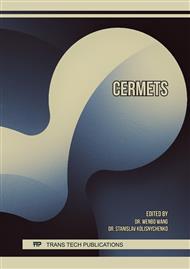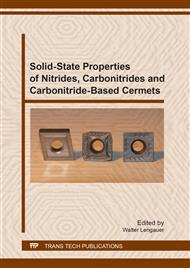[1]
S. Zang, Titanium carbonitride-based cermets: process and properties, Mater. Sci. Eng. A163 (1993) 141-148.
Google Scholar
[2]
P. Ettmayer, H. Kolaska, W. Lengauer, K. Dreyer, Ti(CN) cermets: metallurgy and properties, Int. J. Refract. Met. Hard Mater. 13 (1995) 343-351.
DOI: 10.1016/0263-4368(95)00027-g
Google Scholar
[3]
Y. Peng, H. Miao, Z. Peng, Development of TiCN-based cermets: mechanical properties and wear mechanism, Int. J. Refract. Met. Hard Mater. 39 (2013) 78-89.
DOI: 10.1016/j.ijrmhm.2012.07.001
Google Scholar
[4]
A. Rajabi, Chemical composition, microstructure and sintering temperature modifications on mechanical properties of TiC-based cermet-a review, M.J. Ghazali, A.R. Daud, Mater. Des. 67 (2015) 95-106.
DOI: 10.1016/j.matdes.2014.10.081
Google Scholar
[5]
E.B. Clark, B. Roebuck, Extending the application areas for titanium carbonitride cermets, Int. J. Refract. Met. Hard Mater. 11 (1992) 23-33.
DOI: 10.1016/0263-4368(92)90081-c
Google Scholar
[6]
N. Liu, S. Chao, H.D. Yang, Cutting performances, mechanical property and microstructure of ultra-fine grade Ti(C, N)-based cermets, Int. J. Refract. Met. Hard Mater. 24 (2006) 445-452.
DOI: 10.1016/j.ijrmhm.2005.09.001
Google Scholar
[7]
X.B Zhang, N. Liu, Microstructure, mechanical properties and thermal shock resistance of nano-TiN modified TiC-based cermets with different binders, Int. J. Refract. Met. Hard Mater. 26 (2008) 575-582.
DOI: 10.1016/j.ijrmhm.2008.01.008
Google Scholar
[8]
B.L. Ezquerra, N. Rodriguez, J.M. Sánchez, Comparison of the damage induced by thermal shock in hardmetals and cermets, Int. J. Refract. Met. Hard Mater. 61 (2016) 147-150.
DOI: 10.1016/j.ijrmhm.2016.09.008
Google Scholar
[9]
Hiroyuki Hosokawa, Kiyotaka Katou, Koji Shimojima, Ryoichi Furushima, Akihiro Matsumoto, Microstructural Evaluation of Ti(C0.7N0.3)-Mo2C-xNbC-Ni Cermets, Materials Transactions, 56(9) (2015) 1539-1543.
DOI: 10.2320/matertrans.y-m2015817
Google Scholar
[10]
S.G. Huang, L. Li, O. Van der Biest, J. Vleugels, VC-and Cr3C2-doped WC-NbC-Co hardmetals, J Alloys Compd., 464 (1) (2008) 205-211.
DOI: 10.1016/j.jallcom.2007.10.038
Google Scholar
[11]
S.G. Huang, R.L. Liu, L. Li, O. Van der Biest, J. Vleugels, NbC as grain growth inhibitor and carbide in WC-Co hardmetals, Int. J. Refract. Met. Hard Mater., 26 (5) (2008) 389-395.
DOI: 10.1016/j.ijrmhm.2007.09.003
Google Scholar
[12]
B.V.M. Kumar Bikramjit Basuet,Joze Vizintin and Mitjan Kalina , Tribochemistry in sliding wear of TiCN-Ni-based cermets, J. Mater. Res., 23 (5) (2008) 1214-1227.
DOI: 10.1557/jmr.2008.0165
Google Scholar
[13]
F. Qi, S. Kang, a study on microstructural changes in Ti(CN)-NbC-Ni cermets. Mater. Sci. Eng., A 251, 276 (1998) 276-285.
DOI: 10.1016/s0921-5093(98)00609-1
Google Scholar
[14]
H. O. Pierson, in: Handbook of refractory carbides and nitrides; Properties, Characteristics, Processing and Applications, (Noyes Publications, Westwood, New Jersey, U.S.A., 1996) p.93.
Google Scholar
[15]
A. Bock, W.D. Schubert, B. Lux, Inhibition of Grain Growth on Submicron Cemented Carbides. Powder Metall. Int. 24 (1992) 20-26.
Google Scholar
[16]
R.K. Sadangi, L.E. McCandlish, B.H. Kear, P. Seegopaul, Grain Growth Inhibition in Liquid Phase Sintered Nanophase WC/Co Alloys. Int. J. Powder. Met. 35 (1999) 27-33.
Google Scholar
[17]
B. Wittmann, W.D. Schubert, B. Lux, WC Grain Growth and Grain Growth Inhibition in Nickel and Iron Binder Hardmetals. Int. J. Refract. Met. Hard. Mater. 20 (2002) 51-60.
DOI: 10.1016/s0263-4368(01)00070-1
Google Scholar
[18]
S. Ahn, S. Kang, effect of various carbides on the dissolution behavior of Ti(C0.7N0.3) in a Ti(C0.7N0.3)-30 Ni system. Int. J. Refract. Met. Hard Mater. 19 (2001) 539-545.
DOI: 10.1016/s0263-4368(01)00044-0
Google Scholar
[19]
W.T. Kwon, J.S. Park, S.W. Kim, and S. Kang: Effect of WC and group IV carbides on the cutting performance of Ti(C,N) cermet tools. Int. J. Machine Tools Manufact. 44 (2004) 341-346.
DOI: 10.1016/j.ijmachtools.2003.10.023
Google Scholar
[20]
M. Woydt, H. Mohrbacher, Friction and wear of binderless niobium carbide, Wear 306 (2013) 126-130.
DOI: 10.1016/j.wear.2013.07.013
Google Scholar
[21]
M. Woydt, H. Mohrbacher, The tribological and mechanical properties of niobium carbides (NbC) bonded with cobalt or Fe3Al, Wear 321 (2014) 1-7.
DOI: 10.1016/j.wear.2014.09.007
Google Scholar
[22]
S.G. Huang, L. Li, O. Van der Biest, J. Vleugels. Influence of WC addition on the microstructure and mechanical properties of NbC-Co cermets. J. Alloys Compd. 430 (2007) 158-164.
DOI: 10.1016/j.jallcom.2006.05.015
Google Scholar
[23]
S.G. Huang, J. Vleugels, H. Mohrbacher, M. Woydt, Microstructure and tribological performance of NbC-Ni cermets modified by VC and Mo2C. Int. J. Refract. Met. Hard Mater. 66 (2017) 188-197.
DOI: 10.1016/j.ijrmhm.2017.03.012
Google Scholar
[24]
S.G. Huang, J. Vleugels, H. Mohrbacher, M. Woydt, NbC grain growth control and mechanical properties of Ni bonded NbC cermets prepared by vacuum liquid phase sintering. Int. J. Refract. Met. Hard Mater. 72 (2018) 63-70.
DOI: 10.1016/j.ijrmhm.2017.12.013
Google Scholar
[25]
H.M. Rietveld, A profile refinement method for nuclear and magnetic structures. J. Appl. Crystallogr. 2 (1969) 65-71.
Google Scholar
[26]
D.K. Shetty, I.G. Wright, P.N. Mincer, A.H. Clauer, Indentation fracture of WC-Co cermets. J. Mater. Res., 20 (1985) 1873-1882.
DOI: 10.1007/bf00555296
Google Scholar
[27]
Haksung Moon, Byung-Ki Kim, Suk-Joong L. Kang, Growth mechanism of round-edged NbC grains in Co liquid. Acta Materialia, 49(7) (2001) 1293-1299.
DOI: 10.1016/s1359-6454(00)00394-3
Google Scholar
[28]
F. Delannay, L. Froyen, A. Deruyttere, Review: The wetting of solids by molten metals and its relation to the preparation of metal-matrix composites. J. Mater. Sci. 22 (1987) 1-16.
DOI: 10.1007/bf01160545
Google Scholar
[29]
https://www.webelements.com.
Google Scholar
[30]
Q.Q. Yang, W.H. Xiong, M. Zhang, B. Huang, S. Chen. Microstructure and mechanical properties of Mo-free Ti(C,N)-based cermets with Ni-xCr binders. J. Alloy. Compd. 636 (2015) 270-274.
DOI: 10.1016/j.jallcom.2014.11.236
Google Scholar
[31]
L. Ramqvist. Variation of hardness, resistivity, and lattice parameter with carbon content of group 5 b metal carbides. Jernkontorets Ann. 152 (1968) 465.
Google Scholar



